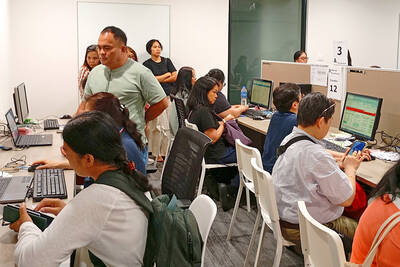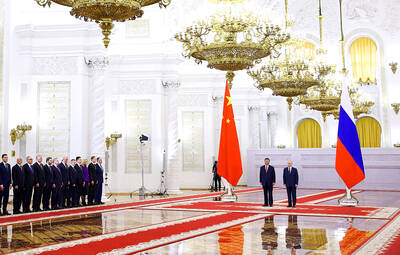Global newspaper chiefs have some rare good news to share after years of slumping print sales and advertising revenues — readers appear increasingly willing to pay for online news.
More than 1,000 newspaper editors and other media figures are meeting in Bangkok this week as papers continue to shed readers — at least in the older markets — and the shift to the Internet draws more “eyeballs,” but lower ad rates.
Press freedom, the safety of journalists, the use of new technology and future trends in print and advertising will all also be discussed at the four-day annual World Newspaper Congress, which runs until tomorrow.
The issue of charging readers for Web and mobile content looms largest, with editors casting an envious eye at media groups who have successfully implemented “paywalls” after years of giving away news for free.
“The general impression was that it would be impossible to reverse the culture of free [online] content ... that people will never pay for it,” Gilles Demptos of the World Association of Newspapers and News Publishers said.
“The great news is that is changing dramatically,” he added, citing the boom in paid-for online subscriptions for the “high-quality” journalism of the New York Times and Financial Times.
Last month, the New York Times became the second most-read US daily newspaper, with a circulation of more than 1 million, boosted by 325,000 new digital readers — who have joined since a paywall was introduced in 2011.
For US$35 a month subscribers gain unlimited access to the New York Times’ Web site and mobile apps, while casual visitors to its Web site can still read 10 articles without charge per month.
The paywall trend — either full or “metered” — has tentatively taken off across the world, although many publishers closely guard the numbers of paying subscribers signed up.
Newspapers have few choices, Demptos said, as advertisers continue to balk at spending on a diffuse online audience the sums editors want — and need — to sustain quality journalism.
“It’s often repeated that a dollar in print becomes a dime online,” Demptos said, adding that the US’ biggest publisher, Gannett Company, has introduced paywalls on all of its 80 Web sites, while metered access was offsetting ad declines at Hong Kong’s South China Morning Post.
While that should be a harbinger of better times ahead, analysts say it is a model that may only buoy top-end titles, such as the New York Times, even though just a fraction of its unique users now pay for content.
“There are many newspapers that are not very good that are trying to charge and I do not believe that will work,” media commentator and blogger Jeff Jarvis of City University in New York said.
Moreover, the newspaper industry’s “infatuation with paywalls” was encouraging it “to replicate its old, industrial business models in a new, digital reality,” he said, adding the real problem remains a lack of “engagement” with Web communities.
Those young, tech-savvy communities are increasingly receiving their information on reader-driven social news sites such as BuzzFeed.com or Reddit, which says 70 million people visited its site last month.
Newspapers should prioritize “building a stronger relationship with the public we serve,” Jarvis said, warning success in doing so would dictate the odds of long-term survival.
However, it is not all doom and gloom for news chiefs, with many Asian print markets booming in parallel with their economies and increasingly literate and aspirational populations.
“I have absolute confidence in Asia,” said Pichai Chuensuksawadi, editor-in-chief of Thailand’s Post Publishing, which counts the daily Bangkok Post in its stable.
“It’s still a growth market driven mainly by China, India and Indonesia,” he said.

A new online voting system aimed at boosting turnout among the Philippines’ millions of overseas workers ahead of Monday’s mid-term elections has been marked by confusion and fears of disenfranchisement. Thousands of overseas Filipino workers have already cast their ballots in the race dominated by a bitter feud between President Ferdinand Marcos Jr and his impeached vice president, Sara Duterte. While official turnout figures are not yet publicly available, data from the Philippine Commission on Elections (COMELEC) showed that at least 134,000 of the 1.22 million registered overseas voters have signed up for the new online system, which opened on April 13. However,

EUROPEAN FUTURE? Albanian Prime Minister Edi Rama says only he could secure EU membership, but challenges remain in dealing with corruption and a brain drain Albanian Prime Minister Edi Rama seeks to win an unprecedented fourth term, pledging to finally take the country into the EU and turn it into a hot tourist destination with some help from the Trump family. The artist-turned-politician has been pitching Albania as a trendy coastal destination, which has helped to drive up tourism arrivals to a record 11 million last year. US President Donald Trump’s son-in-law, Jared Kushner, also joined in the rush, pledging to invest US$1.4 billion to turn a largely deserted island into a luxurious getaway. Rama is expected to win another term after yesterday’s vote. The vote would

ALLIES: Calling Putin his ‘old friend,’ Xi said Beijing stood alongside Russia ‘in the face of the international counter-current of unilateralism and hegemonic bullying’ Chinese President Xi Jinping (習近平) yesterday was in Moscow for a state visit ahead of the Kremlin’s grand Victory Day celebrations, as Ukraine accused Russia’s army of launching air strikes just hours into a supposed truce. More than 20 foreign leaders were in Russia to attend a vast military parade today marking 80 years since the defeat of Nazi Germany in World War II, taking place three years into Russia’s offensive in Ukraine. Putin ordered troops into Ukraine in February 2022 and has marshaled the memory of Soviet victory against Nazi Germany to justify his campaign and rally society behind the offensive,

CONFLICTING REPORTS: Beijing said it was ‘not familiar with the matter’ when asked if Chinese jets were used in the conflict, after Pakistan’s foreign minister said they were The Pakistan Army yesterday said it shot down 25 Indian drones, a day after the worst violence between the nuclear-armed rivals in two decades. Pakistani Prime Minister Shehbaz Sharif vowed to retaliate after India launched deadly missile strikes on Wednesday morning, escalating days of gunfire along their border. At least 45 deaths were reported from both sides following Wednesday’s violence, including children. Pakistan’s military said in a statement yesterday that it had “so far shot down 25 Israeli-made Harop drones” at multiple location across the country. “Last night, India showed another act of aggression by sending drones to multiple locations,” Pakistan military spokesman Ahmed